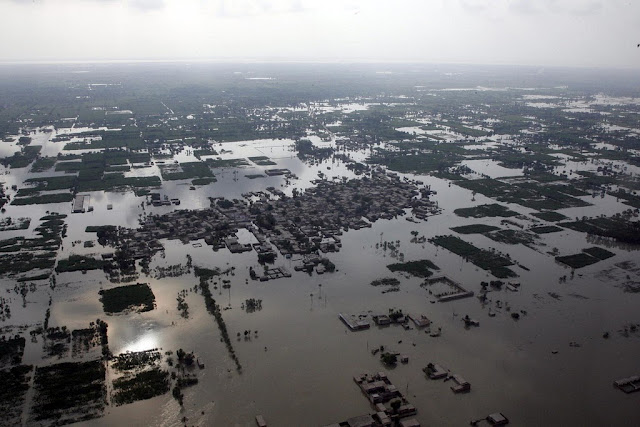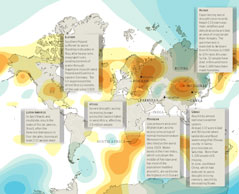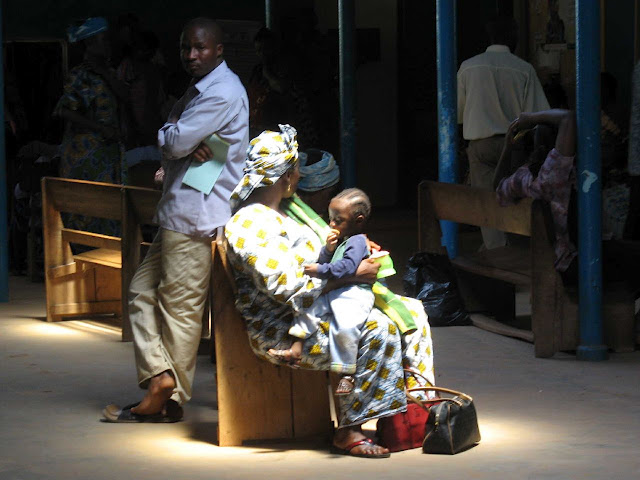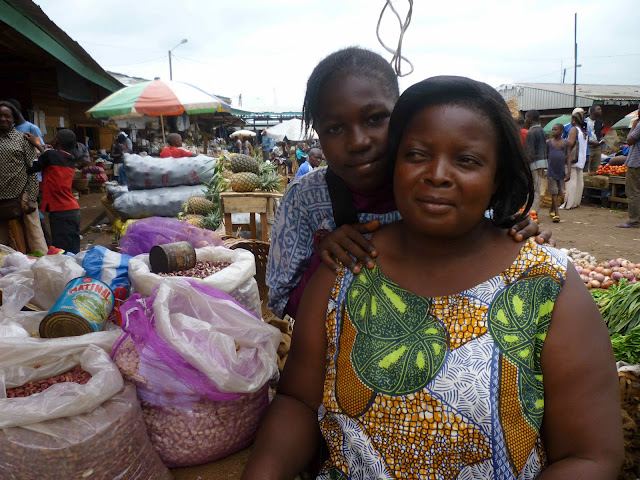-
Historic Floods Plague Pakistan
›August 19, 2010 // By Shawna Cuan“Staggered by the scale of destruction from this summer’s catastrophic floods, Pakistani officials have begun to acknowledge that the country’s security could be gravely affected,” reports the Washington Post. The Pakistani government – already cash-strapped between fighting “the war on terror” and trying to prevent an economic collapse – now faces recovering from the worst flooding in over 80 years.
-
Fire in the Hole: A Look Inside India’s Hidden Resource War
›August 18, 2010 // By Schuyler Null -
Floods, Fire, Landslides, and Drought: The Guardian’s “Weather Crisis 2010”
› From the Guardian’s DataBlog comes an excellent overview of some of the extreme weather affecting the globe this summer, from the devastating floods in Pakistan which have inflicted “huge losses” to crops and exacerbated an already tenuous security situation, to the wildfires in Russia which have smothered the capital in dangerous smog and crippled domestic wheat supplies.
From the Guardian’s DataBlog comes an excellent overview of some of the extreme weather affecting the globe this summer, from the devastating floods in Pakistan which have inflicted “huge losses” to crops and exacerbated an already tenuous security situation, to the wildfires in Russia which have smothered the capital in dangerous smog and crippled domestic wheat supplies.
“Global temperatures in the first half of the year were the hottest since records began more than a century ago,” writes author and graphic artist Mark McCormick.
The orange areas of the map represent high pressure systems and the blue, low pressure systems, which as explained by Peter Stott of the Met Office, are important indicators of the rare climatic conditions that caused this summer’s abnormal conditions across Eurasia.
The flooding in Pakistan has garnered the most international attention, having now affected more people than the 2004 tsunami, 2010 Haiti earthquake, and 2005 Kashmir earthquake combined. Other highlighted areas of the map include flooding in Poland and Germany, drought in England, mudslides in Latin and South America, record-breaking drought and hunger in West Africa, and flooding and landslides in China, which recently pushed the world’s largest hydroelectric dam to its limit and have now been blamed for more than 1,000 deaths.
Although it does a good job highlighting the frequency and severity of extreme weather events this summer, it’s important to note that the map only covers events in July and August. That leaves out the “1000-year” floods in Tennessee this May as well as the heavy snowfall seen in the Northeast United States and the winter of “white death” in Mongolia earlier this year, which also severely disrupted local and national infrastructure as well as a great many people’s livelihoods.
Sources: Agence France-Presse, BBC, Guardian, National Oceanic and Atmospheric Administration, New York Times, Telegraph, UN Dispatch.
Image Credit: “Weather Crisis 2010” by Mark McCormick, courtesy of Scribd user smfrogers and The Guardian. -
Interview With Wilson Center’s Maria Ivanova: Engaging Civil Society in Global Environmental Governance
›August 13, 2010 // By Russell SticklorFrom left to right, the five consecutive Executive Directors of the United Nations Environment Programme: Achim Steiner, Klaus Toepfer, Elizabeth Dowdeswell, Mostafa Tolba, and Maurice Strong, at the 2009 Global Environmental Governance Forum in Glion, Switzerland.
In the eyes of much of the world, global environmental governance remains a somewhat abstract concept, lacking a strong international institutional framework to push it forward. Slowly but surely, however, momentum has started to build behind the idea in recent years. One of the main reasons has been the growing involvement of civil society groups, which have demanded a more substantial role in the design and execution of environmental policy—and there are signs that environmental leaders at the international level are listening.
On the heels of the UN Environment Programme’s Governing Council meeting earlier this year in Bali, a call was put out to strengthen the involvement of civil society organizations in the current environmental governance reform process. To that end, UNEP is creating a Civil Society Advisory Group on International Environmental Governance, which will act as an information-sharing intermediary between civil society groups and regional and global environmental policymaking bodies over the next few years. (The application deadline has been extended; applicants interested in joining the Advisory Group should submit their materials via e-mail by Sunday, August 15, 2010—full instructions are listed at the end of this post.)
Maria Ivanova, a fellow at the Woodrow Wilson Center and director of the Global Environmental Governance Project, played a key role in ensuring civil society engagement in the contemporary political process on international environmental governance reform. Ivanova recently sat down with the New Security Beat to talk about the future prospects for global environmental governance, the Rio+20 Earth Summit in Brazil in 2012, and how to foster a more open and sustained dialogue between the worlds of environmental policymaking and academia.
New Security Beat: What are the pitfalls of a regional approach to addressing climate change and other environmental issues, as opposed to an international approach?
Maria Ivanova: Global environmental problems cannot be solved by one country or one region alone, and require a collective global response. But they can also not be addressed solely at the global level because they require action by individuals and organizations in particular geographies. The conundrum with climate change is that the countries and regions most affected are the ones least responsible for causing the problem in the first case. We cannot therefore simply substitute a national or regional response for a global action plan, as more often than not, it would be a case of “victim pays” rather than “polluter pays”—the fundamental principle of environmental policy in the United States and most other countries. Importantly, however, our global environmental institutions do not possess the requisite authority and ability to enforce agreements and sanction non-compliance.
NSB: What are some of the inherent difficulties in getting countries to see eye-to-eye and collaborate on the development of institutions for global environmental governance?
MI: The most important difficulty is perhaps the lack of trust and a common ethical paradigm accompanied by a pervasive suspicion about countries’ motives. Secondly, there is a perceived dichotomy between environment and development that has lodged in the consciousness of societies around the world. Thirdly, there’s the inability of current institutions to deliver on existing commitments. The resulting blame game feeds suspicions and restarts the whole cycle again.
NSB: Do you see the 21st century’s various environmental challenges as being a driver of international conflict or cooperation?
MI: After the fall of the Berlin Wall, it was expected that global environmental (and other) issues would be a driver for cooperation. A green dividend was expected, and the 1992 Rio Earth Summit fostered much hope. But quite the opposite happened. Global environmental challenges such as climate change, for example, have caused more conflict than cooperation. Other concerns, such as whaling and biodiversity loss, have also triggered conflicts as governments have become fiercely protective of their national sovereignty. On the other hand, civil society groups and even individuals around the world have come together in new coalitions and formed new alliances. So while at a governmental level we observe increased tension, at a civil society level, we witness unprecedented mobilization and collaboration, especially through social media. Obviously, we live in a new world.
NSB: There has been a lot of talk about bridging the gap between the academic and policy worlds—two communities that do not typically have much interaction, but likely have a lot to learn from one another. What steps do you think can be taken regarding environmental governance that might facilitate a sustained dialogue and interaction between the two sides?
MI: Many academics have thought, debated, and written about global environmental governance. Fewer have presented their analysis to policymakers and politicians. At the Global Environmental Governance (GEG) Project that I direct, we seek to bridge that gap and provide a clearinghouse of information, serving as a “brutal analyst,” and acting as an honest broker among various groups working in this field. Moreover, we are in the process of launching a collaborative initiative among the Global Environmental Governance Project, the Center for Law and Global Affairs at Arizona State University, and the Academic Council on the UN System to collect, compile, and communicate academic thinking on options for reform to the ongoing political process on international environmental governance. We are creating a Linked-In group where we hope to engage in discussions with colleagues from universities around the world with the purpose of generating ideas, developing options, and testing them with policymakers. Moreover, we are engaging with civil society beyond academia. The GEG Project is sponsoring five regional events on governance in Argentina, China, Ethiopia, Nepal, and Uganda that are taking place in August and September. Led by young environmental leaders in those countries who attended the 2009 Global Environmental Governance Forum in Glion, Switzerland, these consultations are generating genuine engagement in thought and action on governance. So, new initiatives are certainly emerging and the results could be visible by the Rio+20 conference in May 2012.
NSB: What are your expectations for Rio+20?
MI: Given that governance is a major issue on the agenda for Rio+20, my hope is that the conference will bring about a new model for global governance, which reframes the environment-development dichotomy, cultivates shared values, and fosters leadership. Indeed, I am convinced that leadership is the most important necessary condition for change. We need to encourage more bold, visionary, entrepreneurial behavior rather than conformity.
My hidden hope for Rio+20 is that it will dramatically shift the narrative and move us from sustainable development to sustainability. Sustainability builds on sustainable development but goes further than that. As a concept it allows for new thinking, new actors, and new politics. It avoids the North-South polarization of sustainable development, which is so often equated with development and is therefore understood as what the North has already attained and what the South is aspiring to. By contrast, no one society has reached sustainability, and learning by all is necessary. Moreover, much of the innovative thinking about sustainability is happening in developing countries, which are trying to improve quality of life without jeopardizing the carrying capacity of the environment. Progressive thinking is also taking place on campuses in industrialized countries, which are creating a new sense of community and collaboration. Indeed, young people around the world are engaging in finding new ways of living within the planetary limits in a responsible and fulfilling manner.
Maria Ivanova is director of the Global Environmental Governance Project, a fellow at the Woodrow Wilson International Center for Scholars, and an assistant professor of global governance at the McCormack Graduate School of Policy and Global Studies, University of Massachusetts Boston.
If you wish to nominate yourself or someone else as a candidate for the Civil Society Advisory Group on IEG, you need to submit materials to civil.society@unep.org by Sunday, August 15, 2010 (please copy info@environmentalgovernance.org). You can find the nomination form and the Terms of Reference for the group at the Global Environmental Governance Project’s website.
Photo Credit: “UNEP Leadership,” courtesy of the Global Environmental Governance Project. -
‘UK Royal Society: Call for Submissions’ “People and the Planet” Study To Examine Population, Environment, Development Links
›August 12, 2010 // By Wilson Center StaffBy Marie Rumsby of the Royal Society’s In Verba blog.
In the years that followed the Iranian revolution, when Ayatollah Khomeini returned from exile to Tehran and the country went to war against Iraq, the women of Iran were called upon to provide the next generation of soldiers. Following the war the country’s fertility rate fell from an average of over seven children per woman to around 1.7 children per woman – one of the fastest falls in fertility rates recorded over the last 25 years.
Iran is an interesting example but every country has its own story to tell when it comes to population levels and rates of change. The global population is rising and is set to hit 9 billion by 2050. And whilst fertility rates in Ethiopia are on the decline, its total population is projected to double from around 80 million today, to 160 million in 2050.
Earlier this month, the Royal Society announced it is undertaking a new study which will look at the role of global population in sustainable development. “People and the Planet” will investigate how population variables – such as fertility, mortality, ageing, urbanization, and migration – will be affected by economies, environments, societies, and cultures, over the next 40 years and beyond.
The group informing the study is chaired by Nobel Laureate Sir John Sulston FRS, and includes experts from a range of disciplines, from all over the world. With names on the group such as Professor Demissie Habte (President of the Ethiopian Academy of Sciences), Professor Alastair Fitter FRS (Professor Environmental Sciences, University of York) and Professor John Cleland FBA (Professor of Medical Demography, London School of Hygiene and Tropical Medicine), there’s bound to be some lively discussions.
Linked to the announcement of the study, the Society held a PolicyLab with Fred Pearce, environmental journalist, and Jonathon Porritt, co-founder of Forum for the Future, to discuss the significance of population in sustainable development.
Both speakers have been campaigning against over-consumption for many years. Jonathon Porritt has been a keen advocate for fully funded, fully engaged voluntary family planning in every country in the world that wants it.
“In my opinion, that would allow us to stabilize global population at closer to 8 billion, rather than 9 billion. And if we did it seriously for forty years, that is an achievable goal.” Porritt thinks that stabilizing global population at 8 billion rather than 9 billion would save a large number of women’s lives, and suggests “you cannot ignore the gap between 8 billion and 9 billion if you are thinking seriously about climate change.”
Fred Pearce acknowledges that population matters, but stresses that it is consumption (and how we produce what we produce) that we need to focus on. He feels it is too convenient for us to focus on population.
According to Fred, the global average is now 2.6 children per woman – that’s getting close to the global replacement level of 2.3 children per woman.
“It is no longer human numbers that are the main threat……It’s the world’s consumption patterns that we need to fix, not its reproductive habits,” said Pearce.
The Society will be taking a long look at some of these issues, assessing the latest scientific evidence and uncertainty around population levels and rates of change. The “People and the Planet” study is due for publication in early 2012, ahead of the Rio+20 UN Earth Summit. The Society is currently seeking evidence to inform this study from a wide-range of stakeholders.
The deadline for submissions is October 1, 2010. For more information on submissions, please see the Royal Society’s full call for evidence announcement.
Image Credit: “In Verba” courtesy of the Royal Society. -
Misguided Projections for Africa’s Fertility
›By assuming that sub-Saharan Africa’s total fertility rate will decrease to 2.5 children per woman by 2050, the most recent population projections issued by the Population Reference Bureau likely continue to underestimate fertility for Africa. Though northern Africa has significantly lowered fertility, sub-Saharan Africa’s TFR is still 5 children per woman. Achieving the levels projected by PRB or the United Nations will largely depend on whether the conditions that led to past fertility declines for other states can be established in sub-Saharan Africa.
Demographers have identified numerous factors associated with fertility decline, including increased education for females, shifting from a rural agricultural economy to an industrial one, and introduction of contraceptive technology. Sub-Saharan Africa is only making slow progress in each of these areas.
Surveying Obstacles to Development
Primary school enrollment is up, but the pace of improvement is declining. Meanwhile, gender gaps persist: Enrollment for boys remains significantly higher than for girls. Girls’ education is associated with lower fertility, partly because education helps women take charge of their fertility and also because education influences employment opportunities. Increased female labor force participation has been shown to increase the cost of having children, and is therefore associated with initial fertility declines.
Disease is one wildcard for Africa that limits the utility of past models of demographic transition in the African context. HIV/AIDS is decimating sub-Saharan Africa’s adult workforce and creating shortages of teachers that will impede future efforts to boost primary school enrollment. According to the United Nations, the number of teachers in sub-Saharan Africa needs to double in the next five years to reach Millennium Development goals.
Development that would shift the region’s economies from agriculture to industry is also lagging. While several West African countries are seeing some gains, the African continent on the whole faces major structural impediments to development. In The Bottom Billion, Paul Collier points out that many of these countries may have “missed the boat” to attract investment and industry that would pull the region out of poverty, partly because the least developed countries are still not cost-competitive enough when compared with current centers of manufacturing, like China.
Finally, there remains a high unmet need for family planning. One in four women aged 15 to 49 who are married or in union –- and who have expressed an interest in using contraceptives — still do not have access to family planning tools. In general, maternal mortality remains high and adolescents in the poorest households are three times more likely to become pregnant and give birth than those in the richest households, according to the most recent UN Millennium Development Goals report.
Sub-Saharan Africa: Off the Radar?
Sub-Saharan Africa suffers from a lack of attention by the international community and lack of political capacity at home. Many countries in the region are plagued by civil strife and poor governance, and developed countries continue to fall short of development assistance pledges. There is not the same sense of urgency today among developed countries about the global population explosion as there once was. Cold War politics and the environmental and feminist movements motivated much of the study of fertility and funding of population programs during the second half of the 20th century. Attention by governments and NGOs sped the fertility transition among many countries.
Today, the world’s wealthiest countries are not concerned primarily with Africa’s problems, but rather are more concerned with their own population decline and with the national security implications of population trends in areas associated with religious extremism. The recession has further hindered the flow of development funds.
Fertility is the most difficult population component to predict, and demographers must draw on the experiences of other regions to inform assessments of Africa’s population patterns. Demographers seem to be overconfident that Africa’s fertility will follow the pattern of recent declines, particularly in Latin America, which were more rapid than Western Europe’s decline due to the diffusion of technology and knowledge.
Once states begin the demographic transition towards lower fertility and mortality, they have tended to continue, with few exceptions. Therefore, most projections for Africa assume the same linear pattern of decline will hold. Yet, the low priority of Africa’s population issues among the world’s wealthiest states, combined with shortfalls in education, development, and contraception, may mean that the demographic transition in Africa will be slower than predicted.
Projections are useful to give us a picture of what the world could look like if meaningful policy changes are made. In the case of sub-Saharan Africa, prospects for these projections are dim.
Jennifer Dabbs Sciubba is the Mellon Environmental Fellow in the Department of International Studies at Rhodes College in Memphis, Tenn. She is also the author of a forthcoming book, The Future Faces of War: Population and National Security.
Photo Credit: “Waiting,” ECWA Evangel Hospital, Jos, Nigeria, courtesy of flickr user Mike Blyth. -
How Maternal Mortality and Morbidity Impact Economic Development
›“Investing in women and girls is the right thing to do,” says Mayra Buvinic, sector director of the World Bank’s gender and development group. “It is not only fair for gender equality, but it is smart economics.” But while it may be smart economics, many developing countries fail to address the underlying social causes that impact economic growth, such as poverty and gender inequality. Buvinic was joined by Dr. Nomonde Xundu, health attaché at the Embassy of South Africa in Washington, D.C., and Mary Ellen Stanton, senior maternal health advisor at the U.S. Agency for International Development (USAID), at the sixth meeting of the Advancing Policy Dialogue on Maternal Health Series, which addressed the economic impact of maternal mortality and provided evidence for the need for increased investment in maternal health.
-
Flooded With Food Insecurity in Pakistan
›The floods sweeping across Pakistan have caused widespread destruction, ruined livelihoods, displaced millions, and sparked a food crisis. Food prices have skyrocketed across the country as miles of farmland succumb to the deluge, including 1.5 million hectares in Punjab province, Pakistan’s breadbasket and agricultural heartland.
Food insecurity is now rife across the country — yet even before the floods, millions of Pakistanis struggled to access food. Back in 2008, the UN estimated that 77 million Pakistanis were hungry and 45 million malnourished. And while many developing nations have begun to recover from the global food crisis of 2007-08, Pakistan’s food fortunes have remained miserable. Throughout 2010, Pakistan’s two chief food staples, rice and wheat, have cost 30 to 50 percent times more than they did before the global food crisis. Drought, rampant water shortages, and conflict have intensified food insecurity in Pakistan in recent months.
A new edited book volume published by the Wilson Center’s Asia Program, Hunger Pains: Pakistan’s Food Insecurity, examines the country’s food insecurity. The book has already been the subject of a news story and an editorial in the Pakistani newspaper Dawn. The book, edited by Michael Kugelman and Robert M. Hathaway, is based on the 2009 Wilson Center conference of the same name. It assesses food supply challenges, access issues, governance constraints, social and structural dimensions, gender and regional disparities, and international responses.
The book makes a range of recommendations. These include:- Declare hunger a national security issue. Since some of Pakistan’s most food-insecure regions lie in militant hotbeds, hunger should be linked to defense, and food provision projects should be given ample public funding.
- Diversify the crop mix so that Pakistan’s agricultural economy revolves around more than wheat and rice. The country should accord more resources to crops that are less water-intensive and more nutritious.
- Give schools a central focus in food aid and food distribution. Using schools as a venue for food distribution gives parents powerful incentives to send their children to school.
- Tackle the structural dimensions. Strengthening agricultural institutions, improving infrastructure and storage facilities, and injecting capital into a stagnant farming sector are all key to making Pakistan more food-secure. Yet unless Pakistan deals with poverty, landlessness, and entrenched political interests in agriculture, food insecurity will remain.
Michael Kugelman is program associate with the Asia Program at the Woodrow Wilson International Center for Scholars.
Photo Credit: “Chitarl, Pakistan” where floods damaged the way over Lawari pass and killed five in August 2006. Courtesy of flickr user groundreporter
Yearly archive for 2010.
Show all posts












